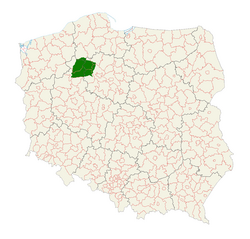Krajna
Krajna | |
|---|---|
| |
 Krajna on the map of Poland | |
| Country | |
| Historical region | Greater Poland |
| Capital | Nakło nad Notecią |
| Largest city | Piła |
| Time zone | UTC+1 (CET) |
| • Summer (DST) | UTC+2 (CEST) |
| Highways | |

Krajna is a forested historical region in the north of Greater Poland in Poland, situated in the border area between the Greater Poland, Kuyavian-Pomeranian and Pomeranian Voivodeships. The region consists of parts of Złotów, Piła, Sępólno, Nakło, Bydgoszcz and Człuchów counties, namely the urban gmina of Złotów, the rural gmina of Złotów and the urban-rural gminas of Krajenka, Wysoka, Wyrzysk, Łobżenica, Kamień Krajeński, Sępólno Krajeńskie, Więcbork, Nakło nad Notecią, Koronowo and Debzno. The name of Krajna is derived from the Slavic word for borderland (between Greater Poland and Pomerania), cf. Krajina.
The main towns in the region are Złotów and Nakło nad Notecią. Since 1932, Krajna has own regional anthem, composed by Paweł "Krajnomir" Jasiek[1]
Part of the region forms a protected area called Krajna Landscape Park.
History[edit]
Krajna formed part of the Greater Poland Province of the Kingdom of Poland. In 1655, it was invaded by Sweden, and the Battle of Ujście was fought there.
During the German occupation of Poland (World War II), the population was subjected to various crimes, including deportations to forced labour and concentration camps, expulsions and executions. A concentration camp for Poles from the region was operated in Radzim, and many were either deported to other concentration camps or massacres at nearby Rudzki Most.[2] Other major sites of massacres of local Poles committed by the SS and Selbstschutz included Paterek, Łobżenica, Górka Klasztorna and Sadki.[3] The Polish resistance movement was active in the region.
The Germans also operated numerous forced labour camps in the region, including several subcamps of the Stalag II-B and Stalag XX-A prisoner-of-war camps for Allied POWs.[4][5] One of the prisoners was future British actor Sam Kydd, who, as he wrote in his memoir, even learned various Polish phrases through contact with the local Polish population.[5]
Towns[edit]
Sites[edit]
References[edit]
- ^ About anthem of Krajna on official site of Kamień Krajeński Commune (Polish)
- ^ Wardzyńska, Maria (2009). Był rok 1939. Operacja niemieckiej policji bezpieczeństwa w Polsce. Intelligenzaktion (in Polish). Warszawa: IPN. pp. 168–169.
- ^ Wardzyńska, pp. 163–164
- ^ "Les Kommandos". Stalag IIB Hammerstein, Czarne en Pologne (in French). Retrieved 3 November 2023.
- ^ a b Bukowska, Hanna (2013). "Obóz jeniecki Stalag XXA w Toruniu 1939-1945". Rocznik Toruński (in Polish). Vol. 40. Towarzystwo Miłośników Torunia, Wydawnictwo Naukowe Uniwersytetu Mikołaja Kopernika. p. 108. ISSN 0557-2177.




